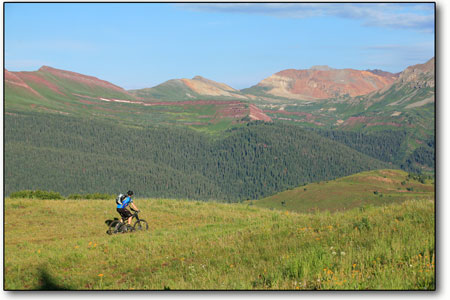A mountain biker rides along the Colorado Trail south of Molas Pass last summer. Mountain biking is one of the activities that would still be allowed on most of the lands protected under the Hermosa Creek Watershed Protection Act of 2013, which would designate about 38,000 of the 108,000 acres it covers as wilderness./Photo by Steve Eginoire
Back in the act
Hermosa Protection Act gets new support, new shot at passage
by Tracy Chamberlin
The act is back. The Hermosa Creek Watershed Protection Act is getting another shot at passage in the 113th U.S. Congress, but this time it has the kind of backing that could make the difference – bipartisan.
The act is back. The Hermosa Creek Watershed Protection Act is getting another shot at passage in the 113th U.S. Congress, but this time it has the kind of backing that could make the difference – bipartisan.
First introduced in 2012 by Sen. Michael Bennet, D-Colo., the bill did not have support from both sides of the aisle. This year Bennet has Cortez native Rep. Scott Tipton, R-Colo., in his corner.
The bill made its comeback at the end of April, introduced by Bennet in the Senate and Tipton in the House, and is currently making its way through Senate and House Committees.
“We’re excited because … it has bipartisan support and strong community support,” said Jimbo Buickerood, public lands coordinator for the San Juan Citizens Alliance.
The diversity of stakeholders and interest groups behind the bill has grown since last year, which is part of the reason for Tipton’s turnaround. “I think he was really impressed with the process,” Buickerood said.
The 19-page document is an attempt to manage and protect almost 108,000 acres in the San Juan National Forest north of Durango by giving it special management and wilderness area designations.
“Snowmobilers, anglers, hunters, other outdoor enthusiasts, elected officials, miners and Southwest Colorado residents have voiced their support to preserve the Hermosa Creek watershed and the multiple use recreation opportunities it provides,” Tipton said.
Most of the land, tagged the Hermosa Creek Watershed Protection Area, would still be open to mountain biking, grazing, some timber harvesting and motorized recreation.
Specifically, the Elbert Creek trail, the Colorado Trail, Little Elk Creek and Goulding Creek trails would remain open for mountain biking. And, the Hermosa Creek, Jones Creek, Pinkerton-Flagstaff, Dutch Creek and Corral Draw trails would be accessible for both mountain biking and motorized recreation.
About 38,000 acres would be designated wilderness and protected under the 1964 Wilderness Act, which does not allow for roads, mechanized recreation or mineral development. It does, however, allow for hiking, fishing, hunting, horseback riding and other types of nonmechanized recreation.
The bill also addresses access concerns when dealing with wildfire, insect infestations and disease outbreaks.
Buickerood said the bulk of the 2013 bill is the same as the 2012 version, both co-sponsored by Sen. Mark Udall, D-Colo. But, it does have a few key changes that address local issues.
First, the level area of mixed forest and meadow adjacent to Molas Lake on the east side of highway 550 would be available for snowmobile use.
According to Buickerood, the area he calls the “bench” is ideal for beginners and setting this aside for that purpose is something the San Juan Citizens Alliance supports. “We see it as the best benefit for the community,” he added.
Something else the alliance supports is a smaller change that transfers 111 acres near Grandview managed by the Bureau of Land Management to La Plata County.
Finally, the 2012 version included protections against future mineral development and oil and gas leasing or exploration on Animas Mountain and the Perins Peak Wildlife Area. The 2013 bill extends those protections to Horse Gulch and Lake Nighthorse.
This particular change in mineral withdrawal prompted the Durango City Council to update its official support of the bill. At Tuesday night’s meeting, council voted to approve a resolution of support for the 2013 version of the bill, joining the La Plata County Board of Commissioners and rounding out community support for the act.
“We are lucky in Colorado to be able to enjoy many of the country’s most beautiful landscapes in our back yards,” Bennet said. “This bill will protect this land for our outdoor recreation economy and for future generations of Coloradans and Americans to enjoy.”
The act is actually the result of local efforts. The Hermosa Creek Workgroup, made up of local water officials, conservationists, sportsmen, mountain bikers, off-road enthusiasts, property owners and others, is one of five groups under the River Protection Workgroup umbrella.
The RPW examined the current protection and management of waterways in the area, and then made suggestions on how those protections could be improved or updated. The other four workgroups include the Animas River, San Juan River, Vallecito Creek/Pine River and Piedra River.
The Hermosa Creek crew put together suggestions for the future management of the Hermosa Creek area after three years of research and discussion, and it’s that list of recommendations that was used to craft the Hermosa Creek Watershed Protection Act of 2013.
“(This bill) is the result of a local effort that took into account the varied interests of the community, and that cooperation helped us put together a strong bill with the community’s input,” Bennet said about the Hermosa workgroup.
With Tipton and local governments on board, the bill now has the kind of support that could make the difference.
Want more watershed? For more information about the Hermosa Creek Watershed Protection Act of 2013 or to view a copy of the legislation, visit www.hermosacreek.org or www.sanjuancitizens.org.
In this week's issue...
- September 11, 2025
- Back on top
After harrowing flying accident, local highliner steps back out with renewed mission
- September 11, 2025
- New order
Rule change for Land and Water Conservation Fund raises alarms
- September 4, 2025
- Armed with knowledge
Local community organizers work to ensure immigrant neighbors know their rights

